
Scenario: A call comes in for a reported fire in a structure (it could be commercial or residential). The caller states that he has smoke in his building but he does not see any fire. Responding units report smoke showing but no visible fire.
 |
| (1) Members drilling on the roof of a commercial structure encounter a gypsum deck over a plywood deck. The supporting members of this roof appear to be 2×4s to allow easier pitching of the roof for drainage. (Photos 1-4 by Dave Topczynski.) |
These responses happen frequently throughout the world. The duties of the first-arriving companies will be to locate the source of the fire and extinguish it properly. If we respond to the fire with heavy smoke that shows no visible fire, then this could be a deep-seated fire in the basement or fire traveling in enclosed spaces such as the attic.
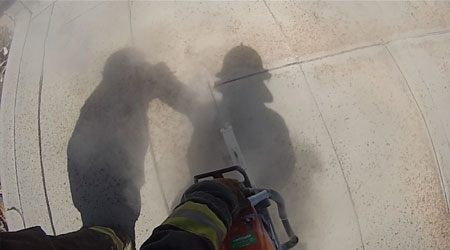 |
| (2) White gypsum dust from saw operations is clearly visible. The member operating a saw under fire conditions should alert the incident commander and evacuate the roof. The member should also leave the roof away from the cut so as not to step on any unsupported areas. |
The incident commander (IC) should be aware of possible fire burning in void spaces throughout the building. These fires can be in knee walls and attics or in balloon-frame buildings. Members operating on the interior of the structure should be aware of the heat conditions. High heat indicates a large volume of fire burning in an enclosed space. Members on the exterior of the building should be aware of the smoke conditions. Changes in the smoke’s color, volume, and movement are critical information and should be communicated to the interior units. Interior units should not open holes in the walls or ceilings indiscriminately. If you open up an inspection hole, it should be small so as to limit the amount of oxygen that could possibly be introduced into the fire area. If you are opening up walls and ceilings, position a charged hoseline to protect the members and extinguish the fire.
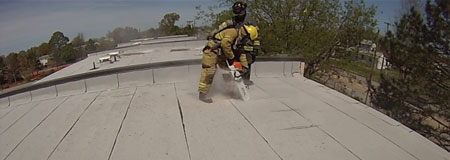 |
| (3) The saw operator and the safety firefighter encounter white dust, the only indication of a gypsum roof deck. Besides the dust, the only other way to know if you are on a gypsum roof deck would be through prior knowledge or an inspection. |
One of several issues that can be a major contributing factor at these types of fires is renovations or changes to the original structure. Whether you are working at a fire in Texas in a private dwelling with the peaked roof over the existing flat roof or you are at a drill in Virginia with new members, you should ALWAYS pay attention to the roofs of these buildings for any possible hidden fire. You may encounter a drop ceiling inserted in the space to replace a damaged ceiling, and the fire can be burning over your head above the original ceiling. Until you pull the entire drop ceiling and expose the original ceiling, you may not be able to get to the seat of the fire.
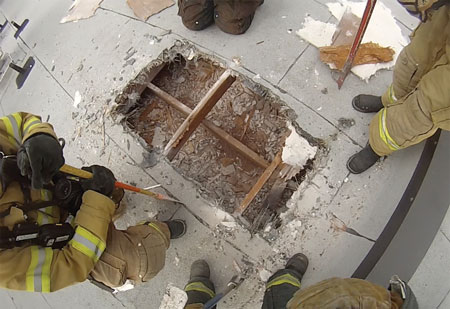 |
| (4) This gypsum deck appears to be pour-in-place. |
One of the most dangerous types of hidden fires involves the roof space. Never overlook buildings that have a problem with leaking water or water accumulation on the roof as well as the possible presence of a roof over (also known as a rain roof or an inverted roof). It’s possible that there can be a large volume of fire that is not visible from the roof or the interior of the structure. Any communications made from the roof or the interior indicating a large volume of fire must be acted on quickly. The roof firefighter may report nothing showing while interior forces have a large volume of fire above the ceiling. He may also indicate a large volume of fire while the interior firefighters are pulling the ceiling and getting to the original roof with nothing showing. These varying reports will indicate fire burning in an enclosed space. The IC must act on the most severe report and never discount the amount of fire reported.
 |
| (5) Heavy smoke shows from around the soffits and the roof area. It is almost impossible to know that the peak was placed over an existing flat roof. (Photos 5-8 by Bo Phillips.) |
Roof replacements may now feature a gypsum roof deck, which can mask the amount of fire burning below it. Firefighters operating on the roof should be aware of the indications of a gypsum deck such as white dust being kicked up during saw operations. A clay or mud substance on the saw indicates a gypsum roof deck that has been damaged by moisture. An issue with this type of material is how it is applied to the roof; gypsum planks are staggered and will not always be resting on the support at the joint. Therefore, if the saw operator cuts the gypsum board near a joint that is unsupported, he may be standing on a piece of gypsum that is also unsupported. This might have catastrophic implications for the saw operator and other members on the roof. So, if you discover gypsum on the roof, it is imperative that the IC decide whether offensive interior operations are warranted and safe.
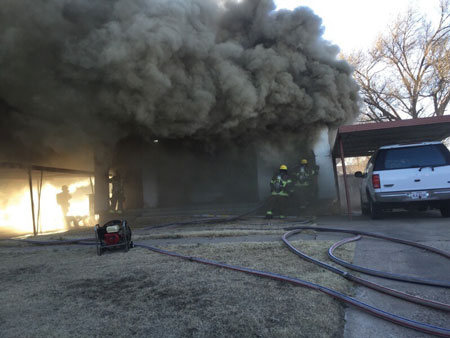 |
| (6) Heavy smoke emanates from around the roof area. High heat in the structure indicates there is fire in the void spaces. |
The Fire Department of New York does not permit operations on a roof with a gypsum deck for the safety of its members. If you give up the roof and possible venting for interior forces, have a defensive operation.
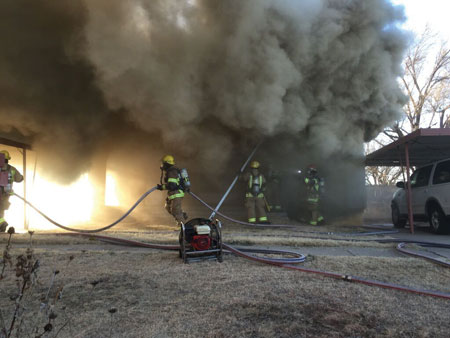 |
| (7) Handlines are in place and ready to operate. As soon as you open up the ceilings and introduce oxygen into the void space, you have to follow that quickly with water. If not, conditions will rapidly become untenable. |
The building is not our friend! And, it was not built to be that way. However, we are the ones who must deal with the construction methods and materials used in a fire. The best way to be informed is to get out and drill on the buildings in your response area. If you are out in your response area and see a new roof as part of the building, stop and see what types of materials and methods are being used on that building. Knowing the hazards we may encounter at the fire before we respond makes us all a lot safer.
 |
| (8) After the fire has been extinguished and a critique has been completed, members can be released from the scene. This is a good time to take photos and raise awareness of issues involving building construction and fires. |
MICHAEL M. DUGAN is a 40-year fire service veteran and a 29-year member of the Fire Department of New York (FDNY), where he served as captain of Ladder Company 123 in Crown Heights, Brooklyn, before his retirement. As a lieutenant, he served in Ladder Company 42 in the South Bronx. While assigned as a firefighter in Ladder Company 43, in Spanish Harlem, he received the James Gordon Bennett Medal in 1992 and the Harry M. Archer Medal in 1993, FDNY’s highest award for bravery. He was a volunteer firefighter in Halesite, New York. He lectures on truck company operations, building construction, size-up, and today’s fire service.
Fire Engineering Archives

